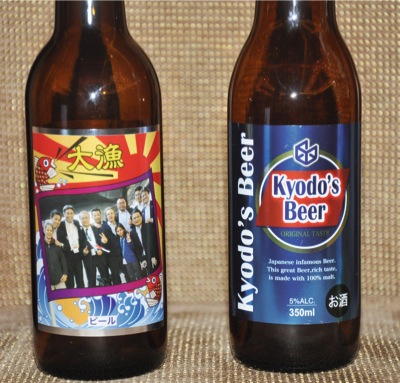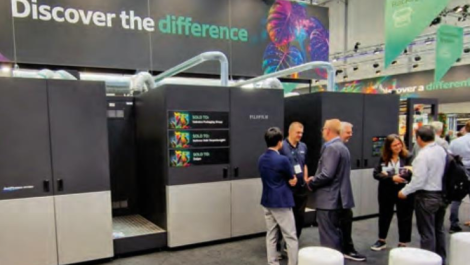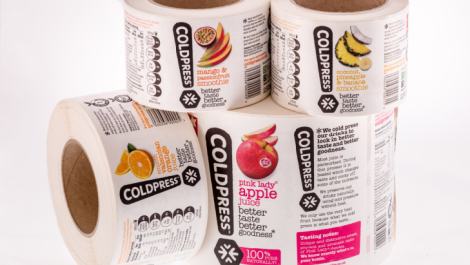Personalised Japanese beer bottles
Dscoop Asia 2013 took place in Beijing in May and very impressive it was too. There were 1,540 delegates from 25 countries present, including a few Europeans and Americans, but the conference was dominated by entrepreneurial Asian print companies eager to learn and network. Sean Smyth reports.
Dscoop is the Digital Systems Co-operative, an HP professional printer user group which organises regular meetings and conferences designed to bring together HP Indigo and inkjet users to share experiences, co-operate and network.
During the conference, a range of workshops was held looking at marketing and production issues, and the labels and packaging sectors were well represented.
There were many examples discussed, from developing new chocolate wraps for Cadbury in India to personalised tea packaging in Japan, from ‘your name on Heinz tomato ketchup’ in India and China to special Kit Kats wrappers in Japan.
Changing nature of print
The keynote presentation was given by Eileen Gittens, CEO of Blurb, a pioneer in photobook printing that now operates a full publishing platform for authors, including an e-book service.
She spoke of the transformation of the industry, from traditional publishing to authors having full control of marketing and production of their own books. A similar experience of finding new applications for an established print product is now happening in packaging.
Alon Bar-Shany, vice president and general manager, HP Indigo, talked about the changing nature of print. Geographically, Asia is becoming more important for the industry, while labels and packaging are fast growing parts of the Indigo business accounting for 20% of sales.
HP hopes its new models are well positioned to gain a share of flexible packaging and carton production. Mr Bar-Shany highlighted the importance of innovation from customers in using the growing number of HP presses (and there are others, of course, although HP is the leader) that is driving impressive growth in labels, corrugated, cartons and flexible packaging.
Heather Graham is senior research director at Perception Research Services International, a multi-national design agency. She highlighted the growing choice of retail products, estimating that in 2012, there were some 30,000 new products and that 95% of these will fail as consumer behaviour changes.
The preferences vary across the region; Chinese shoppers want symmetry in packs and stores, while in India general trade dominates and shoppers have a relationship with the shopkeeper, not the brand.
There are many languages across the country, and often low literacy, so packs tend to devolve into English with high levels of visualisation in graphics. There are opportunities for emotional involvement by using local languages, ideal for digital production.
Tea and sympathy
Daisaku Yamada of HP Japan talked about the changing demands of converters in that country as they target short runs of high value. This has resulted in 400% growth in sales for HP Indigo in 2012.
One application is from Kyodo Gravure, which is producing personalised labels for Sapporo Breweries. As other brand owners learn of the capabilities, they are keen to explore the possibilities.
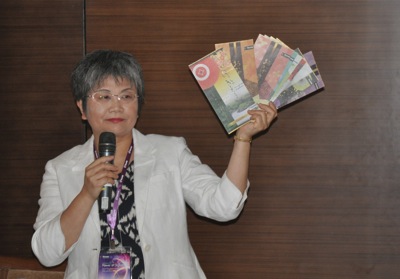 Kumiko Hashimoto of Yoshimura Package Partners with digitally printed tea packs
Kumiko Hashimoto of Yoshimura Package Partners with digitally printed tea packs
Kumiko Hashimoto runs Yoshimura Package Partners Co, a gravure flexible packaging company that specialises in tea packaging. It serves some 8,000 tea shops, farmers and traders, and in 2008, it bought its first digital press, an HP Indigo 4050.
The company now has three of the more productive WS6000 presses and a new WS6600, and it is developing a significant niche in digital flexibles. Non-fermented Japanese teas require specialist packaging where protection from oxygen and light is vital.
The minimum order quantity is 2,000 liner metres (23,000 packs) in gravure, used for the very quality conscious Japanese market. Support customers in testing and prototyping, become a partner in making new products for consumers and some generic designs were sold with mono overprint at smaller quantities but these were not unique.
The company installed WS6000 presses producing short run high quality packs thereby opening up new markets including souvenir shops and tourist associations.
One series produced was a range of amateur Manga comic tea packs, created by enthusiasts to celebrate a comic festival that attracted half a million visitors.
There are also Kawaii packs, small packages aimed at young women working in offices (one translation is ‘small and loveable’, the name deliberately does not just refer to the size) and there are different designs across the seasons.
Tea is special in Japan, with significant cultural and ceremonial implications, and applying a short message on a packet is popular with buyers who can choose from over 50 designs with accompanying message card as gift or a memento of an occasion.
The popular designs are then scaled up in gravure, moving back to digital at the end of the cycle. One novel application is for special commemorative packs with personalisation of the departed given to guests at funerals; a very high value, if niche application, enabled by digital packaging technology.
Mrs Hashimoto explained the work on materials, adhesives and lamination that was performed, and outlined the company’s future plans to move into similar applications for food packaging, expanding factories and digital capacity.
The company has ordered the wider 20000 press from HP Indigo as the Japanese packaging sector is changing from having a closed attitude to promotions toward a more open-mind strategy. Japan is also a big market for Kit Kat.
The name sounds similar to the Japanese phrase ‘Kitto Katsu’ that roughly translates to mean ‘surely win’, used as a term of good luck, which it is for Nestlé. Since 2000, there have been over 200 special edition flavours of the standard chocolate bar, so maybe a personalised version there is not surprising.
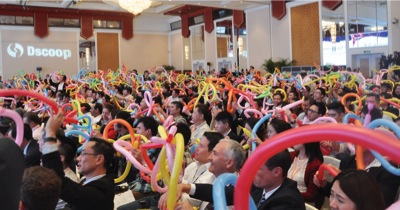 Attendees at Dscoop Beijing enjoying balloon twisting techniques to demonstrate the potential for networking
Attendees at Dscoop Beijing enjoying balloon twisting techniques to demonstrate the potential for networking
Opportunities
Dscoop offered the opportunity to meet and talk with converters from China, Japan, Singapore, India, Korea and Australia, but I was also pleased to see digital pioneers from Pakistan, Bangladesh, the Philippines, Thailand, Taiwan, Sri Lanka, Malaysia and Indonesia, using the latest technology and pushing the market forward across the world.
Using digital for prototypes is now common; one successful Indian example personalises the prototypes to stakeholders in the design and approval team, simplifying the three to four week analogue process down to one week design-to-sale timescale.
The benefits in using digital production of greater flexibility, more colours, fast turnaround and security features while lowering waste are well understood, as is the potential for improved margins, and these are attracting more installations.
As users gain experience, the conversations have changed from being about the technology to how new customer needs can now be fulfilled and how to train production and sales staff to take advantage of the new capabilities. The innovative Asian converters are learning to exploit the possibilities of digital and show interested buyers new things in order to create wants, and hence opening up new markets.
Many of the companies I met are becoming much more proactive with customers, bringing in new ideas not just following the simple brief. They are showing the features of their new digital presses with impressive results. Now, if you want an authentic personalised gifting pack for Diwali (or as I should say, Deepavali) this November, I know a very good source who will be happy to talk to you.

